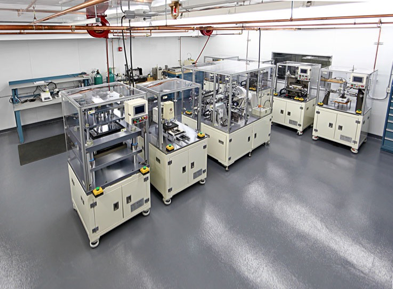
With increasing demand for low-cost batteries, the establishment of a domestic supply chain is a top priority. ORNL is giving US manufacturers a boost by operating the country’s largest open-access battery manufacturing research and development center. The DOE Battery Manufacturing R&D Facility (BMF) provides scientists the ability to analyze every aspect of battery production, from raw materials and electrode dispersion preparation to finished product and performance testing.
ORNL is leveraging the BMF across the continuum of battery research, development, evaluation, and testing, working with partners and Users in materials characterization, materials processing, and materials and systems simulations to identify performance and lifetime limitations, and to develop revolutionary technologies for next-generation batteries as well as low-cost manufacturing processes. Reflective of the interconnectivity between new technology market success and manufacturing efficiency, the BMF is uniquely a part of two ORNL programs and User Facilities—the NTRC and the Manufacturing Demonstration Facility—with the former focusing on energy storage technology R&D specifically for vehicle applications and the latter focusing on roll-to-roll manufacturing R&D.
Open to any US battery manufacturer, material supplier, equipment manufacturer, or battery end user, the BMF offers the ability to integrate any component into a complete battery and analyze how well it works and how it can be improved. The Facility can produce pouch cells of up to 66 × 99 × 12 mm and 7 ampere-hours, large enough to make market decisions yet small enough to affordably demonstrate the impact of innovative technologies.
R&D Focus Areas
- Colloid and dispersion design and characterization
- Mixing and coating technologies and processes
- Advanced drying and solvent removal technologies
- Solventless processing
- Electrode architecture optimization
- Computational manufacturing
- Thermal runaway characterization
Equipment Highlights
- 65 m2 (700 ft2) dry space with less than 0.5% relative humidity
- 65 m2 (700 ft2) space with adjustable 1–15% relative humidity
- Coating and fabrication line
- Reconfigurable modules for
- Deposition
- Drying and consolidation
- Winding, folding, and stacking
- Joining
Low-cost, high-yield coating technologies include high-performance vacuum processing, slot-die, tape casting, spray coating, and direct manufacturing techniques. Coating thicknesses produced can range from nanometers to many hundreds of micrometers with pilot-scale line speeds of up to tens of feet per minute. Configurations are in single-, multi- and simultaneously deposited multi-coatings.
Drying and heating technologies include evaporation of solvents, sintering, polymer curing, and bonding of coatings on diffusion layers of individual materials. Several systems with a variety of integrated layers are available consisting of typical battery drying temperatures between 100–150°C to sintering and heating treatments of up to 3,000°C.
Advanced computational modeling enables rapid prototyping and screening of battery materials and configurations, accurate lifetime predictions, and development of best possible manufacturing parameters for battery manufacturing process steps.
Advanced joining technology R&D is focused on low thermal impact joining including ultrasonic joining techniques.
Thermal runaway characterization is supported by infrared imaging to better understand temperature distribution inside secondary lithium batteries.

